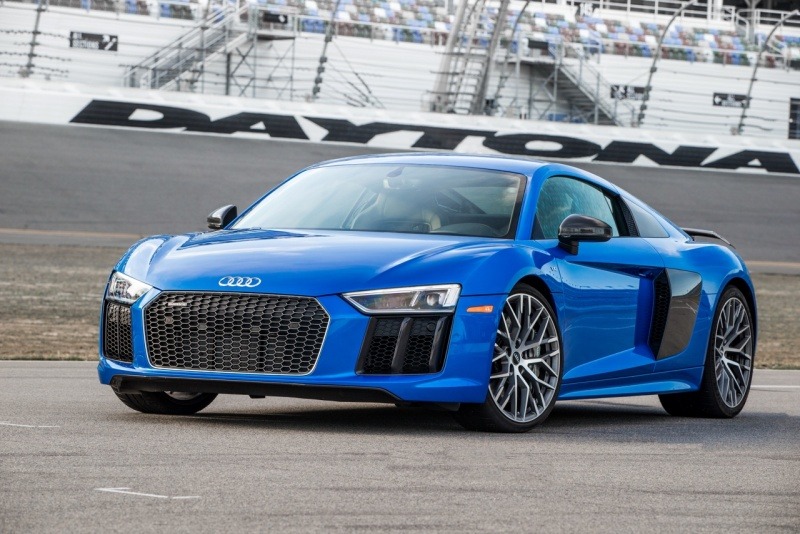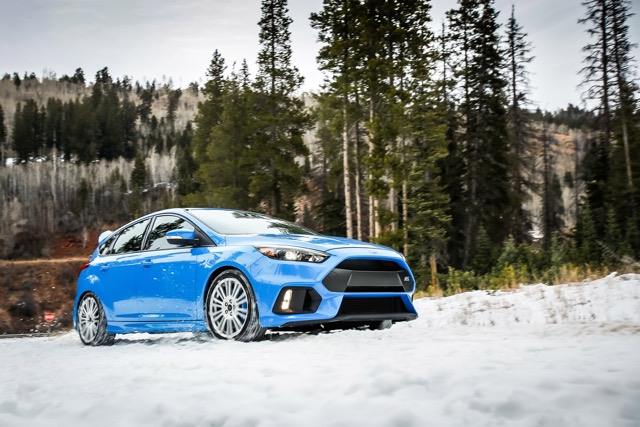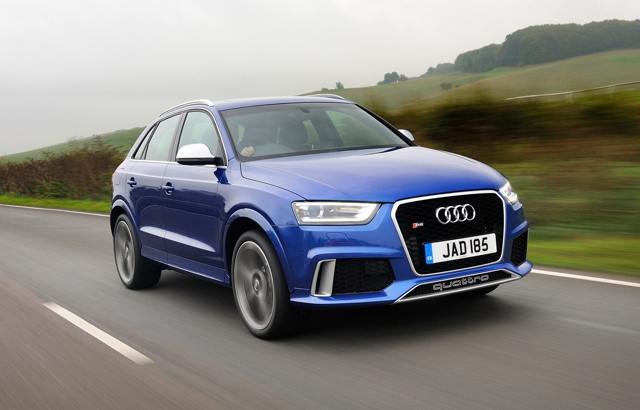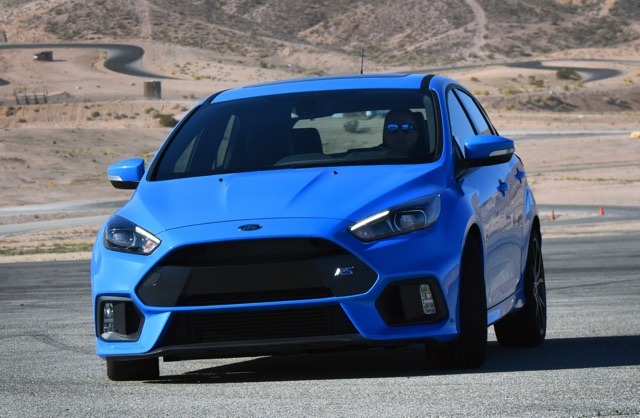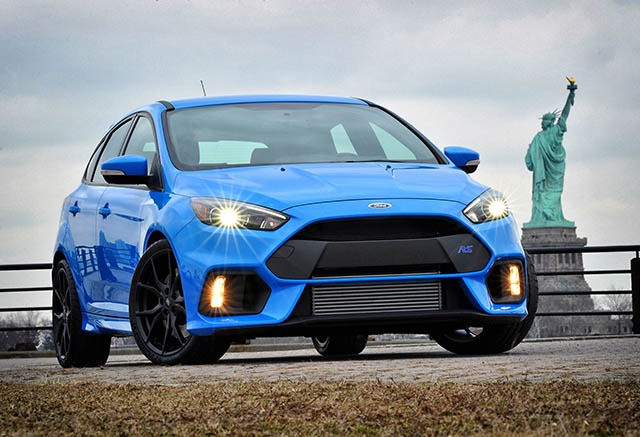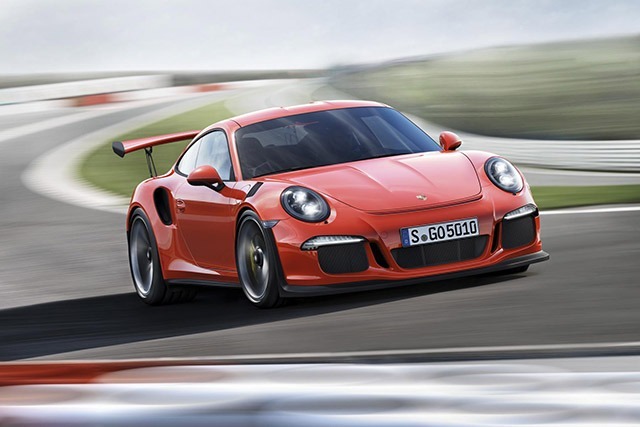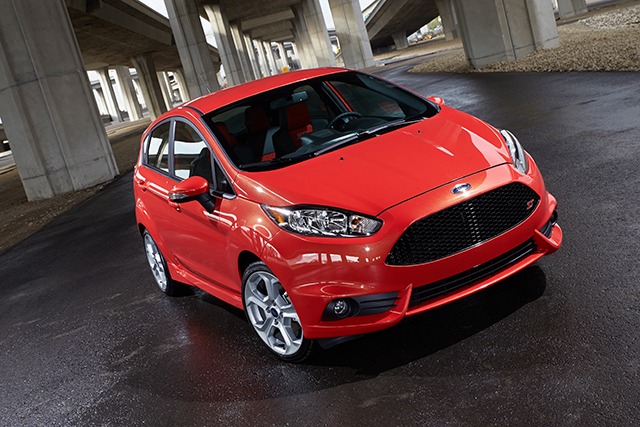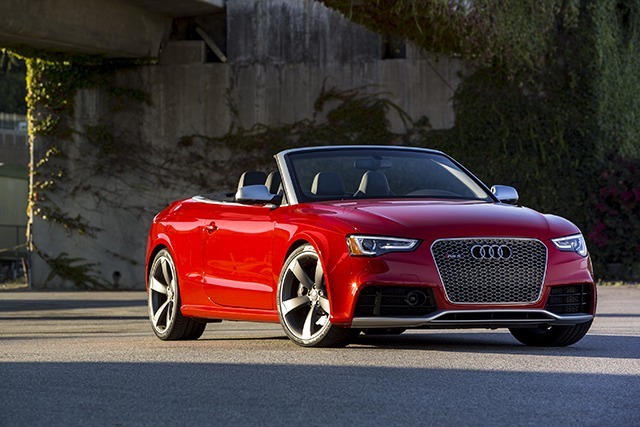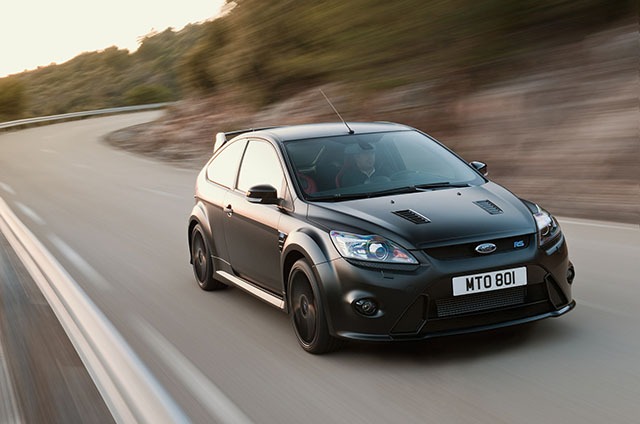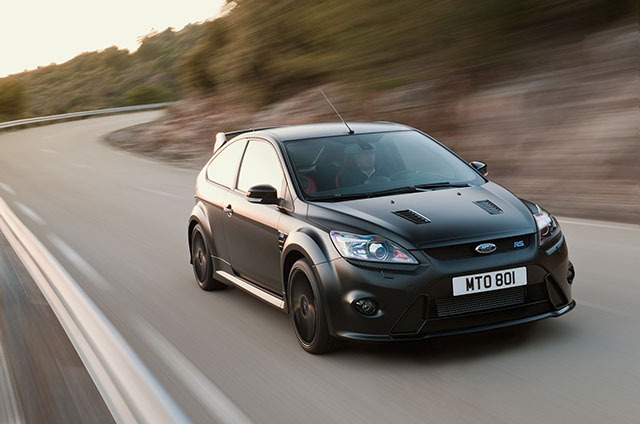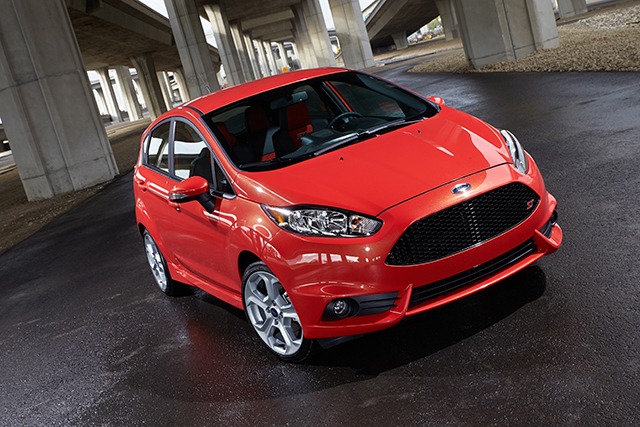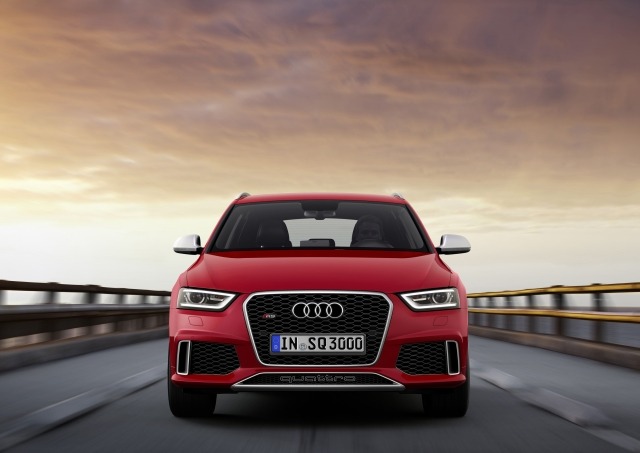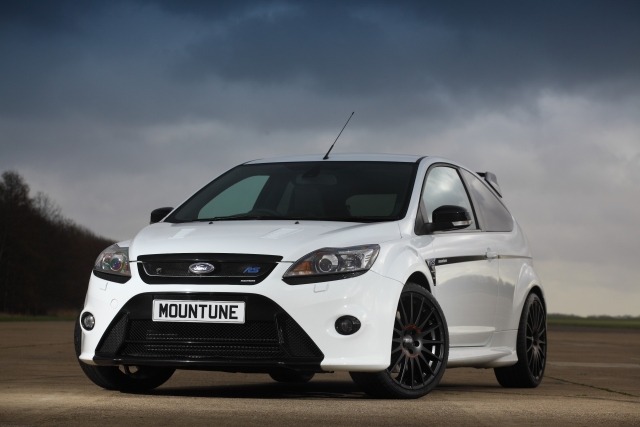Search the Community
Showing results for tags 'RS'.
-
According to a new report from Automobile, the Audi R8 supercar will not have a third-generation model. The report says the R8 is a slow seller and Audi has decided it wouldn't be worth the money to develop a new one. The model will depart in 2020 when the replacement for the Lamborghini Huracán arrives - the R8 shares the same platform and engine. Audi has pulled the plug on a successor to the R8 e-tron and a supercar project known as Scorpion. The latter project would have used a V8 that would be made up of four 1.2L Ducati motorcycle engines. At least other performance projects seem to be on track. The upcoming RS4 and RS5 will use a new 2.9L twin-turbo V6 producing 450 horsepower. This engine is almost nearing its power ceiling as Automobile says the maximum power it can achieve is 470. There is the possibility of a plug-in hybrid powertrain using this engine along with an 85 kW electric motor to produce even more power - although, there are no scheduled plans to add this to either model. The next-generation RS6 and RS7 will retain the 4.0L twin-turbo V8 found in the current models. On top of Audi's RS offerings will be the RS Q8 due in 2020. Basically a coupe-styled version of the Q7, the RS version will use the same 4.0L twin-turbo V8 found in the upcoming Lamborghini Urus that produces 641 horsepower. Source: Automobile View full article
-
According to a new report from Automobile, the Audi R8 supercar will not have a third-generation model. The report says the R8 is a slow seller and Audi has decided it wouldn't be worth the money to develop a new one. The model will depart in 2020 when the replacement for the Lamborghini Huracán arrives - the R8 shares the same platform and engine. Audi has pulled the plug on a successor to the R8 e-tron and a supercar project known as Scorpion. The latter project would have used a V8 that would be made up of four 1.2L Ducati motorcycle engines. At least other performance projects seem to be on track. The upcoming RS4 and RS5 will use a new 2.9L twin-turbo V6 producing 450 horsepower. This engine is almost nearing its power ceiling as Automobile says the maximum power it can achieve is 470. There is the possibility of a plug-in hybrid powertrain using this engine along with an 85 kW electric motor to produce even more power - although, there are no scheduled plans to add this to either model. The next-generation RS6 and RS7 will retain the 4.0L twin-turbo V8 found in the current models. On top of Audi's RS offerings will be the RS Q8 due in 2020. Basically a coupe-styled version of the Q7, the RS version will use the same 4.0L twin-turbo V8 found in the upcoming Lamborghini Urus that produces 641 horsepower. Source: Automobile
-
It is unlikely that the Focus RS will be the only Ford model sporting the RS badge, although which models will follow have been up for debate. The chief of Ford Performance has hinted that the brand's crossovers could go under the RS treatment. "I think customers love performance. I think the definition of what that means for an SUV might be different than what it means for a Focus or for a Fiesta. But I think that we’ve seen, even in the US and globally, that people like aggressive-looking cars, they like sporty, they want the power and pick-up and engine improvement, so I think the answer is yes. SUV customers would appreciate performance, for sure," said Dave Pericak, head of Ford Performance to Car Dealer Magazine. Pericak goes on to say that he believes there are "no real credible (performance SUVs)." (Though we are sure the likes of BMW, Mercedes-Benz, and Porsche would like to have a conversation with him about this -WM). "If you look at the SUV market right now, there aren’t too many credible performance SUVs out there. here are people who have made partial attempts at it and there are different things that have happened, but there are no real credible ones. So, I think that’s an area of some opportunity, for sure." Car Dealer Magazine speculates that the Kuga (Escape to us) could be the most likely candidate, followed by the EcoSport and Edge. Source: Car Dealer Magazine
-
- crossovers
- ford performance
-
(and 2 more)
Tagged with:
-
It is unlikely that the Focus RS will be the only Ford model sporting the RS badge, although which models will follow have been up for debate. The chief of Ford Performance has hinted that the brand's crossovers could go under the RS treatment. "I think customers love performance. I think the definition of what that means for an SUV might be different than what it means for a Focus or for a Fiesta. But I think that we’ve seen, even in the US and globally, that people like aggressive-looking cars, they like sporty, they want the power and pick-up and engine improvement, so I think the answer is yes. SUV customers would appreciate performance, for sure," said Dave Pericak, head of Ford Performance to Car Dealer Magazine. Pericak goes on to say that he believes there are "no real credible (performance SUVs)." (Though we are sure the likes of BMW, Mercedes-Benz, and Porsche would like to have a conversation with him about this -WM). "If you look at the SUV market right now, there aren’t too many credible performance SUVs out there. here are people who have made partial attempts at it and there are different things that have happened, but there are no real credible ones. So, I think that’s an area of some opportunity, for sure." Car Dealer Magazine speculates that the Kuga (Escape to us) could be the most likely candidate, followed by the EcoSport and Edge. Source: Car Dealer Magazine View full article
-
- crossovers
- ford performance
-
(and 2 more)
Tagged with:
-
The only Audi crossover that has the vaunted RS badge is the Q3, but that is going changing in the near future. Speaking with Car and Driver, Audi Sport boss Stephan Winkelmann said there would be more RS-badged crossovers in the near future. “We don’t have a big lineup. The right cars means having them in segments that are growing, and also segments that are equally distributed in the regions of the world. Therefore a CUV shift is due; we are working on it, and you will see it coming.” Sources have previously said that the Q7 and upcoming Q8 will get the RS treatment. There is also the possibility of an RS Q5. One item you will not see under the hood of any RS crossover is a diesel engine. "If I have to put money down for an investment which has to make a return worldwide, then diesel will never be the priority,” said Winkelmann. Source: Car and Driver
- 8 comments
-
- audi
- crossovers
-
(and 3 more)
Tagged with:
-
The only Audi crossover that has the vaunted RS badge is the Q3, but that is going changing in the near future. Speaking with Car and Driver, Audi Sport boss Stephan Winkelmann said there would be more RS-badged crossovers in the near future. “We don’t have a big lineup. The right cars means having them in segments that are growing, and also segments that are equally distributed in the regions of the world. Therefore a CUV shift is due; we are working on it, and you will see it coming.” Sources have previously said that the Q7 and upcoming Q8 will get the RS treatment. There is also the possibility of an RS Q5. One item you will not see under the hood of any RS crossover is a diesel engine. "If I have to put money down for an investment which has to make a return worldwide, then diesel will never be the priority,” said Winkelmann. Source: Car and Driver View full article
- 8 replies
-
- audi
- crossovers
-
(and 3 more)
Tagged with:
-
The Ford Focus RS is already a potent hot hatch with 350 rampaging horses coming from a turbocharged 2.3L four-cylinder and can hit 60 mph in 4.7 seconds. But Ford believes they can go faster. Australian outlet Motor reports that Ford is considering building an even quicker Focus RS. Sources at the blue oval say a hardcore version of the RS is being looked. Now, the 2.3L is operating close to its maximum output. So how does Ford plan on making the RS quicker? By adding lightness with stripping the interior down to the essentials, removing sound deading, and using lighter materials - polycarbonate windows, carbonfiber-reinforced plastic bodywork, and aluminum suspension parts. Motor speculates this will drop 100 kg (about 220 lbs) from the vehicle. Also on the table is a new front bumper and additional vents to improve cooling, a limited-slip differential for the front, and possibly a dual-clutch transmission. Before Ford makes a final decision on whether to go further or not with the RS, they'll be watching demand for the standard model. Source: Motor
-
The Ford Focus RS is already a potent hot hatch with 350 rampaging horses coming from a turbocharged 2.3L four-cylinder and can hit 60 mph in 4.7 seconds. But Ford believes they can go faster. Australian outlet Motor reports that Ford is considering building an even quicker Focus RS. Sources at the blue oval say a hardcore version of the RS is being looked. Now, the 2.3L is operating close to its maximum output. So how does Ford plan on making the RS quicker? By adding lightness with stripping the interior down to the essentials, removing sound deading, and using lighter materials - polycarbonate windows, carbonfiber-reinforced plastic bodywork, and aluminum suspension parts. Motor speculates this will drop 100 kg (about 220 lbs) from the vehicle. Also on the table is a new front bumper and additional vents to improve cooling, a limited-slip differential for the front, and possibly a dual-clutch transmission. Before Ford makes a final decision on whether to go further or not with the RS, they'll be watching demand for the standard model. Source: Motor View full article
-
When Ford revealed to everyone the Focus RS back in February, they said the 2.3L EcoBoost four-cylinder would produce 'well in excess of 315 horsepower' for the model. Today, the Blue Oval announced the final power figures for the Focus RS and it happens to be 'well in excess'. When the Focus RS hits dealers later this year, it will pack 350 horsepower and the same for torque. More impressive is the engine is producing 152 horsepower per liter, let that sink in for a moment. Ford was able to produce these figures by using a twin-scroll turbo delivering a peak boost of 23.2 psi, along with a larger intercooler and performance exhaust. Along with the announcement of performance figures, Ford also introduced a new feature for the Focus RS called Stall Recovery. A function of the stop-start system, Stall Recovery will start the vehicle back up by simply pressing in the clutch after a stall. Source: Ford Press Release is on Page 2 FOCUS RS ENGINEERS DROP THE HAMMER: HOT HATCH BUYERS TO GET MONSTROUS OUTPUT OF 350 HORSEPOWER, 350 LB.-FT. Unique 2.3-liter EcoBoost® engine powering all-new Focus RS certified at 350 horsepower at 6,000 rpm on way to 6,800-rpm redline Exclusive Focus RS turbo makes peak boost of 23.2 psi, with peak torque certified at 350 lb.-ft. at 3,200 rpm Innovative Focus RS feature restarts engine for drivers in the event of a stall DEARBORN, Mich., Oct. 12, 2015 – The unique EcoBoost® engine in the all-new Focus RS will produce 350 horsepower – far exceeding original estimates of 315 – along with 350 lb.-ft. torque. And yet even with all that torque, the manual-only hot hatch will be especially forgiving in the event a driver stalls the engine, as Focus RS will debut with a trick feature called stall recovery. In other words, there will be no need for drivers to manually restart the engine or move the gear selector to neutral as the innovative technology simply pushes the clutch back in. “We knew we wanted to put start-stop technology on the RS,” explained Tyrone Johnson, engineering and vehicle manager, Ford Performance Europe. “So we said, ‘What if we went one step further, and controlled for engine stall at launch using the same technology?’ Well, that’s exactly what we did and it’s just as fast as our start-stop technology.” The monster output the Focus RS engine achieves is due to its all-new low-inertia twin-scroll turbocharger with a larger compressor wheel that delivers more airflow and power throughout the rev range. Peak turbocharger boost is 23.2 psi. Backing up this increased output is a large intercooler to maximize charge density. Air itself is delivered through a low-restriction intake manifold on the front end with a high-performance exhaust. The system includes an electronically controlled valve that optimizes back pressure and exhaust volume level. Stout, high-tensile cast-iron cylinder liners are used to enhance the robustness of the engine, while a high-performance head gasket brings improved thermal capability. Additional space created in the front of the car allowed engineers to deploy a larger radiator than what’s used on other Focus models for enhanced cooling. Despite the engine’s high output of 152 horsepower per liter, RS engineers tuned this EcoBoost to deliver right off idle all the way on up to a free-spinning 6,800 rpm, with an especially chunky midrange power delivery. Focus RS is the latest car to be unveiled as part of a new golden age of Ford Performance. The plan calls for bringing more than 12 high-performance vehicles to market worldwide through 2020. Developed by a small team of Ford Performance engineers in Europe and the United States, the third-generation Focus RS follows on the heels of the much-loved models launched in 2002 and 2009. The 2016 Focus RS is the 30th car globally to wear the vaunted RS badge, joining such legendary models as the 1970 Escort RS1600, the 1984 mid-engine RS200 Group B rally car, 1985 Sierra RS Cosworth and 1992 Escort RS Cosworth. Production of Focus RS with 2.3-liter EcoBoost begins later this year.
-
- 2016
- Engine Output
-
(and 4 more)
Tagged with:
-
When Ford revealed to everyone the Focus RS back in February, they said the 2.3L EcoBoost four-cylinder would produce 'well in excess of 315 horsepower' for the model. Today, the Blue Oval announced the final power figures for the Focus RS and it happens to be 'well in excess'. When the Focus RS hits dealers later this year, it will pack 350 horsepower and the same for torque. More impressive is the engine is producing 152 horsepower per liter, let that sink in for a moment. Ford was able to produce these figures by using a twin-scroll turbo delivering a peak boost of 23.2 psi, along with a larger intercooler and performance exhaust. Along with the announcement of performance figures, Ford also introduced a new feature for the Focus RS called Stall Recovery. A function of the stop-start system, Stall Recovery will start the vehicle back up by simply pressing in the clutch after a stall. Source: Ford Press Release is on Page 2 FOCUS RS ENGINEERS DROP THE HAMMER: HOT HATCH BUYERS TO GET MONSTROUS OUTPUT OF 350 HORSEPOWER, 350 LB.-FT. Unique 2.3-liter EcoBoost® engine powering all-new Focus RS certified at 350 horsepower at 6,000 rpm on way to 6,800-rpm redline Exclusive Focus RS turbo makes peak boost of 23.2 psi, with peak torque certified at 350 lb.-ft. at 3,200 rpm Innovative Focus RS feature restarts engine for drivers in the event of a stall DEARBORN, Mich., Oct. 12, 2015 – The unique EcoBoost® engine in the all-new Focus RS will produce 350 horsepower – far exceeding original estimates of 315 – along with 350 lb.-ft. torque. And yet even with all that torque, the manual-only hot hatch will be especially forgiving in the event a driver stalls the engine, as Focus RS will debut with a trick feature called stall recovery. In other words, there will be no need for drivers to manually restart the engine or move the gear selector to neutral as the innovative technology simply pushes the clutch back in. “We knew we wanted to put start-stop technology on the RS,” explained Tyrone Johnson, engineering and vehicle manager, Ford Performance Europe. “So we said, ‘What if we went one step further, and controlled for engine stall at launch using the same technology?’ Well, that’s exactly what we did and it’s just as fast as our start-stop technology.” The monster output the Focus RS engine achieves is due to its all-new low-inertia twin-scroll turbocharger with a larger compressor wheel that delivers more airflow and power throughout the rev range. Peak turbocharger boost is 23.2 psi. Backing up this increased output is a large intercooler to maximize charge density. Air itself is delivered through a low-restriction intake manifold on the front end with a high-performance exhaust. The system includes an electronically controlled valve that optimizes back pressure and exhaust volume level. Stout, high-tensile cast-iron cylinder liners are used to enhance the robustness of the engine, while a high-performance head gasket brings improved thermal capability. Additional space created in the front of the car allowed engineers to deploy a larger radiator than what’s used on other Focus models for enhanced cooling. Despite the engine’s high output of 152 horsepower per liter, RS engineers tuned this EcoBoost to deliver right off idle all the way on up to a free-spinning 6,800 rpm, with an especially chunky midrange power delivery. Focus RS is the latest car to be unveiled as part of a new golden age of Ford Performance. The plan calls for bringing more than 12 high-performance vehicles to market worldwide through 2020. Developed by a small team of Ford Performance engineers in Europe and the United States, the third-generation Focus RS follows on the heels of the much-loved models launched in 2002 and 2009. The 2016 Focus RS is the 30th car globally to wear the vaunted RS badge, joining such legendary models as the 1970 Escort RS1600, the 1984 mid-engine RS200 Group B rally car, 1985 Sierra RS Cosworth and 1992 Escort RS Cosworth. Production of Focus RS with 2.3-liter EcoBoost begins later this year. View full article
-
- 2016
- Engine Output
-
(and 4 more)
Tagged with:
-
Sports and supercars have been stepping up with power it seems with every new model. There comes a point where the question is raised is there such thing as too much power. Someone at Porsche believes so. Andreas Preuninger, the head of Porsche’s GT division (group behind the 911 GT3) tells Car Magazine that future GT models will pass on the horsepower wars. "I’m not a believer in this horsepower monster, up, up, up, more, more, more. For my personal tastes, around 500bhp is enough, because 700-800bhp calls for bigger brakes, sturdier suspension, it gets heavier and heavier logically," said Preuninger. Preuninger went on to suggest that future GT and RS models will focus on shedding weight and hit a power-to-weight ratio, not adding 50 horsepower for each generation. Now you might think that Porsche will shrink the power that comes out of their engines for these models. Preuninger says the automaker will not do that. Source: Car Magazine View full article
-
Sports and supercars have been stepping up with power it seems with every new model. There comes a point where the question is raised is there such thing as too much power. Someone at Porsche believes so. Andreas Preuninger, the head of Porsche’s GT division (group behind the 911 GT3) tells Car Magazine that future GT models will pass on the horsepower wars. "I’m not a believer in this horsepower monster, up, up, up, more, more, more. For my personal tastes, around 500bhp is enough, because 700-800bhp calls for bigger brakes, sturdier suspension, it gets heavier and heavier logically," said Preuninger. Preuninger went on to suggest that future GT and RS models will focus on shedding weight and hit a power-to-weight ratio, not adding 50 horsepower for each generation. Now you might think that Porsche will shrink the power that comes out of their engines for these models. Preuninger says the automaker will not do that. Source: Car Magazine
-
There could be a hotter Ford Fiesta in the wings. Autocar spoke with Tyrone Johnson, manager of Ford Performance (group that brings together RS and SVT). Johnson revealed that work was being done on a higher-performance Fiesta that would use the current chassis and will likely go on sale within the next couple of years. “There’s more to come from the current Fiesta,” said Johnson. Now Johnson didn't say if this new model would wear a ST or an RS badge. Autocar also asked Johnson about producing something akin to the Focus RS for the Fiesta. “If there’s a business case and if it’s technically feasible.” When pressed if a case could be made, he said “Theoretically, yes.” Source: Autocar
-

Rumorpile: Next-Gen RS4 To Say Goodbye To V8, U.S. Still In Question
William Maley posted an article in Audi
Car and Driver is reporting that the next-generation Audi RS4 will retire the naturally-aspirated 4.2L V8 engine and use a turbocharged V6 engine. This is due to the upcoming emission regulations coming soon to Europe which are very stringent. Now the decision to go with a turbocharged V6 engine strikes us as odd since Audi currently has supercharged V6 that is being used in a number of their models. However Car and Driver says Quattro GmbH, the folks behind RS, is looking towards turbo power for future models. Car and Driver also reports that a decision on whether or not the next-generation RS4 will come to the U.S. hasn't been made. Source: Car and Driver William Maley is a staff writer for Cheers & Gears. He can be reached at [email protected] or you can follow him on twitter at @realmudmonster. -
There could be a hotter Ford Fiesta in the wings. Autocar spoke with Tyrone Johnson, manager of Ford Performance (group that brings together RS and SVT). Johnson revealed that work was being done on a higher-performance Fiesta that would use the current chassis and will likely go on sale within the next couple of years. “There’s more to come from the current Fiesta,” said Johnson. Now Johnson didn't say if this new model would wear a ST or an RS badge. Autocar also asked Johnson about producing something akin to the Focus RS for the Fiesta. “If there’s a business case and if it’s technically feasible.” When pressed if a case could be made, he said “Theoretically, yes.” Source: Autocar View full article
-
Car and Driver is reporting that the next-generation Audi RS4 will retire the naturally-aspirated 4.2L V8 engine and use a turbocharged V6 engine. This is due to the upcoming emission regulations coming soon to Europe which are very stringent. Now the decision to go with a turbocharged V6 engine strikes us as odd since Audi currently has supercharged V6 that is being used in a number of their models. However Car and Driver says Quattro GmbH, the folks behind RS, is looking towards turbo power for future models. Car and Driver also reports that a decision on whether or not the next-generation RS4 will come to the U.S. hasn't been made. Source: Car and Driver William Maley is a staff writer for Cheers & Gears. He can be reached at [email protected] or you can follow him on twitter at @realmudmonster. View full article
-
The Good News: The Truth About Cars is reporting that the Ford Focus RS will be coming to our shores by 2016. The new RS will use the 2.3L EcoBoost four-cylinder and feature all-wheel drive. Expect pricing to be above the $30,000 mark. The Bad News: Ford will likely be importing the RS from Europe. Sources tell TTAC that the Michigan Assembly Plant where the North American Focus is built can't fit the RS into its production line. So that means the RS destined for America will be coming from Europe, and in limited numbers as well. Source: The Truth About Cars William Maley is a staff writer for Cheers & Gears. He can be reached at [email protected] or you can follow him on twitter at @realmudmonster.
-
The Good News: The Truth About Cars is reporting that the Ford Focus RS will be coming to our shores by 2016. The new RS will use the 2.3L EcoBoost four-cylinder and feature all-wheel drive. Expect pricing to be above the $30,000 mark. The Bad News: Ford will likely be importing the RS from Europe. Sources tell TTAC that the Michigan Assembly Plant where the North American Focus is built can't fit the RS into its production line. So that means the RS destined for America will be coming from Europe, and in limited numbers as well. Source: The Truth About Cars William Maley is a staff writer for Cheers & Gears. He can be reached at [email protected] or you can follow him on twitter at @realmudmonster. View full article
-
The past few years have seen a number of rumors about the next-generation Ford Focus RS and if it will come to the U.S. or not. A new report from Road & Track says the Focus RS is coming, with a big change for the U.S. According to a source, Ford is planning to send a limited number of the next Focus RS to the U.S. The next RS will come equipped with a 2.3L EcoBoost four-cylinder. The source says power figures are still be determined, but Road & Track speculates that the RS could be packing 310 to 350 horsepower. As for what wheels all of that power will go to, another source says that it will utilize a new all-wheel drive system with torque vectoring to improve handling. Source: Road & Track William Maley is a staff writer for Cheers & Gears. He can be reached at [email protected] or you can follow him on twitter at @realmudmonster.
-
- All-Wheel Drive
- Focus
- (and 6 more)
-
The past few years have seen a number of rumors about the next-generation Ford Focus RS and if it will come to the U.S. or not. A new report from Road & Track says the Focus RS is coming, with a big change for the U.S. According to a source, Ford is planning to send a limited number of the next Focus RS to the U.S. The next RS will come equipped with a 2.3L EcoBoost four-cylinder. The source says power figures are still be determined, but Road & Track speculates that the RS could be packing 310 to 350 horsepower. As for what wheels all of that power will go to, another source says that it will utilize a new all-wheel drive system with torque vectoring to improve handling. Source: Road & Track William Maley is a staff writer for Cheers & Gears. He can be reached at [email protected] or you can follow him on twitter at @realmudmonster. View full article
-
- All-Wheel Drive
- Focus
- (and 6 more)
-
Rumors are once again flying on the Ford Fiesta RS. Auto Express has learned from sources that Ford has a Fiesta RS in the product plans and is trying to work on a business case for one. The proposed Fiesta RS will use a hopped-up version of the turbocharged 1.6L four-cylinder that will increase horsepower from 179 to 230. There will also be a number of modifications such as new suspension bits, larger brakes, and limited-slip diff. Outside will feature a wild body kit and a set of new wheels to differentiate the RS from the ST. Now if Ford can make a business case, AE says the Fiesta RS could come out by 2015. Source: Auto Express William Maley is a staff writer for Cheers & Gears. He can be reached at [email protected] or you can follow him on twitter at @realmudmonster.
-
Rumors are once again flying on the Ford Fiesta RS. Auto Express has learned from sources that Ford has a Fiesta RS in the product plans and is trying to work on a business case for one. The proposed Fiesta RS will use a hopped-up version of the turbocharged 1.6L four-cylinder that will increase horsepower from 179 to 230. There will also be a number of modifications such as new suspension bits, larger brakes, and limited-slip diff. Outside will feature a wild body kit and a set of new wheels to differentiate the RS from the ST. Now if Ford can make a business case, AE says the Fiesta RS could come out by 2015. Source: Auto Express William Maley is a staff writer for Cheers & Gears. He can be reached at [email protected] or you can follow him on twitter at @realmudmonster. View full article
-
By William Maley Staff Writer - CheersandGears.com February 20, 2013 Audi has pulled back the curtain on the production RS Q3 before its debut at the Geneva Motor Show in March. The RS Q3 stands out from other Q3s by number of small changes on the exterior. There is a high-gloss black honeycomb front grille, RS front bumper, a rear diffuser with a single oval tailpipe, roof spoiler, exclusive 19-inch or 20-inch wheels, and body accents. Inside the RS Q3 is a set of sport seats in black Alcantara and leather, a revised instrument cluster, a flat–bottom steering wheel, and a load of aluminum trim. Powering the RS Q3 is a turbocharged 2.5L five-cylinder engine producing 310 horsepower and 310 pound-feet of torque. 0-60 MPH takes only 5.5 seconds. All of that power goes through seven-speed S-tronic dual-clutch transmission to Audi's quattro all-wheel drive system. quattro engineers (Audi's performance arm) tweaked and lowered the suspension on the RS Q3. Other changes include larger brakes, selectable drive modes, and launch control. The RS Q3 arrives in Europe later this fall. Source: Audi Album: 2014 Audi RS Q3 3 images 0 comments William Maley is a staff writer for Cheers & Gears. He can be reached at [email protected] you can follow him on twitter at @realmudmonster. Press Release is on Page 2 First RS model in the Q series: Audi RS Q3 quattro GmbH chief van Meel: “The compact Audi RS Q3 creates a new class in the SUV segment.” Combines excellent power with outstanding everyday practicality 2.5 TFSI with 228 kW (310 hp) and 420 Nm (309.78 lb-ft), 0 to 100 km/h (62.14 mph) in 5.5 s Audi is presenting the RS Q3 at the Geneva International Motor Show, the first RS model for the successful Q line-up. It combines outstanding everyday practicality with dynamic driving performance: It takes just 5.5 seconds to complete the sprint from 0 to 100 km/h (62.14 mph), and its top speed is electronically governed to 250 km/h (155.34 mph). The 2.5-liter five-cylinder turbo produces 228 kW (310 hp) and has an average fuel consumption of just 8.8 liters of fuel per 100 km (26.73 US mpg). “The RS Q3 transfers the performance philosophy of Audi to the compact SUV segment, thereby creating a new performance class,” says Franciscus van Meel, Managing Director of quattro GmbH. “In addition to the RS 5 Cabriolet, RS 6 Avant and RS 7 Sportback, the RS Q3 is the fourth RS model that we are launching on the market in 2013. The RS family is growing to eight members – more than ever.” The RS Q3 combines typical RS properties such as high performance and driving pleasure with lifestyle qualities and high utility value. The Audi RS Q3 was developed by quattro GmbH which is a wholly-owned subsidiary of AUDI AG. An award-winning high-performance engine, the 2.5 TFSI, is at work under the hood of the RS Q3. This five-cylinder engine has been named “International Engine of the Year” in its class for three consecutive years since 2010 by an international jury of automotive specialists. From 2,480 cc of engine displacement, the turbocharged direct-injection engine produces a maximum power of 228 kW (310 hp) at 5,200-6,700 rpm; its maximum torque of 420 Nm (309.78 lb-ft) is available between 1,500 and 5,200 rpm. These two values signify that the RS Q3 is unrivaled in its competitive field. This five-cylinder is a special engine, beginning with its fundamental concept. It is familiar from the TT RS and RS 3 Sportback, and quattro GmbH modified it for use in the RS Q3. The 1-2-4-5-3 ignition sequence, supported by the geometry of the air induction and exhaust systems, generates a sporty engine sound that first made Audi popular back in the 1980s. Drivers can influence the flap control for the exhaust system and the accelerator characteristic by choosing one of the modes auto, comfort and dynamic using the standard Audi drive select system. In the dynamic mode, engine response is sharper and the engine sound more intensive. The 2.5 TFSI accelerates the Audi RS Q3 from a standstill to 100 km/h (62.14 mph) in just 5.5 seconds – the best performance value in this segment. The vehicle’s top speed is electronically limited to 250 km/h (155.34 mph). In the RS Q3, the Audi five-cylinder engine is working together with a standard start-stop-system for the first time. Other efficiency measures such as a regulated oil pump, which only pumps lubricant when needed, contribute to the car’s low average fuel consumption of 8.8 liters of fuel per 100 km (26.73 US mpg) which equates to 206 grams CO2 per km (331.52 g/mile). A standard seven-speed S tronic transfers power to the drivetrain. It was designed in a compact three-shaft configuration, and its seventh gear has a long gear ratio to save on fuel. Drivers can choose between the D and S modes for automatic shifting of the dual clutch transmission, or they can shift manually – using the shift paddles on the steering wheel or the selector lever that sports a unique RS design. The Launch Control function controls acceleration from a standstill to attain optimal traction. The heart of the quattro permanent all-wheel drive system is the hydraulically operated and electronically controlled multi-plate clutch located at the rear axle. It ensures proper distribution of torque between the front and rear axles. The Audi RS Q3 impresses with dynamic and stable handling without sacrificing comfort. The RS sports suspension lowers the body of the compact high-performance SUV by 25 mm (0.98 in). The battery is located in the luggage compartment to achieve better weight distribution. The independent rear wheel suspensions are controlled by four links. The electro-mechanical rack and pinion steering system operates very efficiently, conveying a stiff, precise steering feeling. An electro-mechanical parking brake and hill hold assist are also standard. In the RS Q3, the internally ventilated and perforated brake discs at the front wheels have a wave design with wave-shaped outer contours, which saves approx. one kilogram (2.20 lb) of weight at the front wheels. The discs have a diameter of 365 mm (14.37 in), and they are gripped by eight-piston calipers painted black with RS logos. The electronic stabilization control (ESC) has a sport mode, and it can also be deactivated entirely. The Audi RS Q3 comes on the German market with standard 19-inch alloy wheels. Three versions of 20-inch wheels are offered as well. One of these is the exclusive 5 dual-spoke V design, which is based on the Audi RS Q3 concept car that was shown at the 2012 Auto China motor show. In addition to its engine, the Audi RS Q3 also demonstrates its special status within the Q3 line-up with a number of visual highlights. RS-specific design details emphasize the confident look of the compact, high-performance SUV. They consist of body accents and roof rails in matt aluminum, special door sill plates and door trim strips, a high-gloss black honeycomb front grille, RS front bumper and quattro emblem in the front air intake. A large roof spoiler, rear bumper with distinctive diffuser insert, large elliptical tailpipe and an RS Q3 logo accentuate the rear. At a length of 4,410 mm (14.47 ft), the dynamic top model is 25 mm (0.98 in) longer than the Audi Q3. It weighs in at 1,730 kg (3814.00 lb). The Audi RS Q3 can also be customized by one of two optional styling packages – matt aluminum or black. Styling features include the flaps in the side air intakes, the trim on the diffuser and the fins on the roof spoiler. The Audi RS Q3 is available in eight exterior colors, including the exclusive Sepang Blue pearl effect. The sporty lines of the exterior are continued in the interior styling. The instrument cluster has gray gauges with white scales and red pointers. Contrasting stitching in rock gray trim the three-spoke multifunction steering wheel with its flat bottom as well as the gear selector lever. The MMI and driver information system displays welcome the driver with the RS logo. Drivers can call up the boost pressure, oil temperature and a lap timer via the RS menu in the driver information system. Along with the pedals, a foot support also shines in aluminum look, and the standard inlays are in piano finish black. quattro GmbH offers aluminum race or carbon as alternatives here. Black headlining is standard, and lunar silver headlining is optional. Sport seats with embossed RS Q3 logos are also standard and are upholstered in black Alcantara/leather. Customers can also choose the optional Fine Nappa leather in black or lunar silver with contrasting stitching in rock gray or the design package with diamond stitching. The cargo area has a base capacity of 356 liters (12.57 cubic ft), which can be increased to 1,261 liters (44.53 cubic ft) by folding down the split rear seat backs. A practical reversible loadliner is standard. Those wishing to transport even more cargo can order the towing bracket that is offered for the RS Q3. Other standard features of the Audi RS Q3 include – in addition to the RS-specific driver information system – park assist plus, Audi sound system with ten loudspeakers, xenon plus headlights and LED tail lights. When they are not lit, the tail lights display a dark red tint. In the infotainment area, a modular component system offers a wide range of options; at the top there is the hard-drive based navigation system, MMI Navigation plus. The surround sound system from Bose drives 14 loudspeakers with up to 465 watts of output power, while the Bluetooth car phone online together with WLAN hotspot connects the compact high-performance SUV with the Internet and brings the online services of Audi connect into the vehicle. Highly advanced driver assistance systems round out the options program. In Germany, the base price is €54,600, and deliveries begin in fall 2013. View full article
-
By William Maley Staff Writer - CheersandGears.com February 20, 2013 Audi has pulled back the curtain on the production RS Q3 before its debut at the Geneva Motor Show in March. The RS Q3 stands out from other Q3s by number of small changes on the exterior. There is a high-gloss black honeycomb front grille, RS front bumper, a rear diffuser with a single oval tailpipe, roof spoiler, exclusive 19-inch or 20-inch wheels, and body accents. Inside the RS Q3 is a set of sport seats in black Alcantara and leather, a revised instrument cluster, a flat–bottom steering wheel, and a load of aluminum trim. Powering the RS Q3 is a turbocharged 2.5L five-cylinder engine producing 310 horsepower and 310 pound-feet of torque. 0-60 MPH takes only 5.5 seconds. All of that power goes through seven-speed S-tronic dual-clutch transmission to Audi's quattro all-wheel drive system. quattro engineers (Audi's performance arm) tweaked and lowered the suspension on the RS Q3. Other changes include larger brakes, selectable drive modes, and launch control. The RS Q3 arrives in Europe later this fall. Source: Audi Album: 2014 Audi RS Q3 3 images 0 comments William Maley is a staff writer for Cheers & Gears. He can be reached at [email protected] you can follow him on twitter at @realmudmonster. Press Release is on Page 2 First RS model in the Q series: Audi RS Q3 quattro GmbH chief van Meel: “The compact Audi RS Q3 creates a new class in the SUV segment.” Combines excellent power with outstanding everyday practicality 2.5 TFSI with 228 kW (310 hp) and 420 Nm (309.78 lb-ft), 0 to 100 km/h (62.14 mph) in 5.5 s Audi is presenting the RS Q3 at the Geneva International Motor Show, the first RS model for the successful Q line-up. It combines outstanding everyday practicality with dynamic driving performance: It takes just 5.5 seconds to complete the sprint from 0 to 100 km/h (62.14 mph), and its top speed is electronically governed to 250 km/h (155.34 mph). The 2.5-liter five-cylinder turbo produces 228 kW (310 hp) and has an average fuel consumption of just 8.8 liters of fuel per 100 km (26.73 US mpg). “The RS Q3 transfers the performance philosophy of Audi to the compact SUV segment, thereby creating a new performance class,” says Franciscus van Meel, Managing Director of quattro GmbH. “In addition to the RS 5 Cabriolet, RS 6 Avant and RS 7 Sportback, the RS Q3 is the fourth RS model that we are launching on the market in 2013. The RS family is growing to eight members – more than ever.” The RS Q3 combines typical RS properties such as high performance and driving pleasure with lifestyle qualities and high utility value. The Audi RS Q3 was developed by quattro GmbH which is a wholly-owned subsidiary of AUDI AG. An award-winning high-performance engine, the 2.5 TFSI, is at work under the hood of the RS Q3. This five-cylinder engine has been named “International Engine of the Year” in its class for three consecutive years since 2010 by an international jury of automotive specialists. From 2,480 cc of engine displacement, the turbocharged direct-injection engine produces a maximum power of 228 kW (310 hp) at 5,200-6,700 rpm; its maximum torque of 420 Nm (309.78 lb-ft) is available between 1,500 and 5,200 rpm. These two values signify that the RS Q3 is unrivaled in its competitive field. This five-cylinder is a special engine, beginning with its fundamental concept. It is familiar from the TT RS and RS 3 Sportback, and quattro GmbH modified it for use in the RS Q3. The 1-2-4-5-3 ignition sequence, supported by the geometry of the air induction and exhaust systems, generates a sporty engine sound that first made Audi popular back in the 1980s. Drivers can influence the flap control for the exhaust system and the accelerator characteristic by choosing one of the modes auto, comfort and dynamic using the standard Audi drive select system. In the dynamic mode, engine response is sharper and the engine sound more intensive. The 2.5 TFSI accelerates the Audi RS Q3 from a standstill to 100 km/h (62.14 mph) in just 5.5 seconds – the best performance value in this segment. The vehicle’s top speed is electronically limited to 250 km/h (155.34 mph). In the RS Q3, the Audi five-cylinder engine is working together with a standard start-stop-system for the first time. Other efficiency measures such as a regulated oil pump, which only pumps lubricant when needed, contribute to the car’s low average fuel consumption of 8.8 liters of fuel per 100 km (26.73 US mpg) which equates to 206 grams CO2 per km (331.52 g/mile). A standard seven-speed S tronic transfers power to the drivetrain. It was designed in a compact three-shaft configuration, and its seventh gear has a long gear ratio to save on fuel. Drivers can choose between the D and S modes for automatic shifting of the dual clutch transmission, or they can shift manually – using the shift paddles on the steering wheel or the selector lever that sports a unique RS design. The Launch Control function controls acceleration from a standstill to attain optimal traction. The heart of the quattro permanent all-wheel drive system is the hydraulically operated and electronically controlled multi-plate clutch located at the rear axle. It ensures proper distribution of torque between the front and rear axles. The Audi RS Q3 impresses with dynamic and stable handling without sacrificing comfort. The RS sports suspension lowers the body of the compact high-performance SUV by 25 mm (0.98 in). The battery is located in the luggage compartment to achieve better weight distribution. The independent rear wheel suspensions are controlled by four links. The electro-mechanical rack and pinion steering system operates very efficiently, conveying a stiff, precise steering feeling. An electro-mechanical parking brake and hill hold assist are also standard. In the RS Q3, the internally ventilated and perforated brake discs at the front wheels have a wave design with wave-shaped outer contours, which saves approx. one kilogram (2.20 lb) of weight at the front wheels. The discs have a diameter of 365 mm (14.37 in), and they are gripped by eight-piston calipers painted black with RS logos. The electronic stabilization control (ESC) has a sport mode, and it can also be deactivated entirely. The Audi RS Q3 comes on the German market with standard 19-inch alloy wheels. Three versions of 20-inch wheels are offered as well. One of these is the exclusive 5 dual-spoke V design, which is based on the Audi RS Q3 concept car that was shown at the 2012 Auto China motor show. In addition to its engine, the Audi RS Q3 also demonstrates its special status within the Q3 line-up with a number of visual highlights. RS-specific design details emphasize the confident look of the compact, high-performance SUV. They consist of body accents and roof rails in matt aluminum, special door sill plates and door trim strips, a high-gloss black honeycomb front grille, RS front bumper and quattro emblem in the front air intake. A large roof spoiler, rear bumper with distinctive diffuser insert, large elliptical tailpipe and an RS Q3 logo accentuate the rear. At a length of 4,410 mm (14.47 ft), the dynamic top model is 25 mm (0.98 in) longer than the Audi Q3. It weighs in at 1,730 kg (3814.00 lb). The Audi RS Q3 can also be customized by one of two optional styling packages – matt aluminum or black. Styling features include the flaps in the side air intakes, the trim on the diffuser and the fins on the roof spoiler. The Audi RS Q3 is available in eight exterior colors, including the exclusive Sepang Blue pearl effect. The sporty lines of the exterior are continued in the interior styling. The instrument cluster has gray gauges with white scales and red pointers. Contrasting stitching in rock gray trim the three-spoke multifunction steering wheel with its flat bottom as well as the gear selector lever. The MMI and driver information system displays welcome the driver with the RS logo. Drivers can call up the boost pressure, oil temperature and a lap timer via the RS menu in the driver information system. Along with the pedals, a foot support also shines in aluminum look, and the standard inlays are in piano finish black. quattro GmbH offers aluminum race or carbon as alternatives here. Black headlining is standard, and lunar silver headlining is optional. Sport seats with embossed RS Q3 logos are also standard and are upholstered in black Alcantara/leather. Customers can also choose the optional Fine Nappa leather in black or lunar silver with contrasting stitching in rock gray or the design package with diamond stitching. The cargo area has a base capacity of 356 liters (12.57 cubic ft), which can be increased to 1,261 liters (44.53 cubic ft) by folding down the split rear seat backs. A practical reversible loadliner is standard. Those wishing to transport even more cargo can order the towing bracket that is offered for the RS Q3. Other standard features of the Audi RS Q3 include – in addition to the RS-specific driver information system – park assist plus, Audi sound system with ten loudspeakers, xenon plus headlights and LED tail lights. When they are not lit, the tail lights display a dark red tint. In the infotainment area, a modular component system offers a wide range of options; at the top there is the hard-drive based navigation system, MMI Navigation plus. The surround sound system from Bose drives 14 loudspeakers with up to 465 watts of output power, while the Bluetooth car phone online together with WLAN hotspot connects the compact high-performance SUV with the Internet and brings the online services of Audi connect into the vehicle. Highly advanced driver assistance systems round out the options program. In Germany, the base price is €54,600, and deliveries begin in fall 2013.
-
By William Maley Staff Writer - CheersandGears.com February 9, 2013 For almost two years, we've been reporting on the rumors of the next generation Ford Focus RS. The model is reportedly coming with a 2.3L turbocharged four-cylinder that will be shared with the next-generation Mustang, producing close to 330 horsepower. The new Focus RS would stick with its front-wheel drive layout and use the RevoKnuckle front suspension. Now, the Focus RS might have gotten a date. According to Autocar, the plans for the Focus RS were axed due Ford focusing more on raising sales volumes and cut costs by working on their mass-market models.But with profits on the rise, the economy in the U.S. becoming stable, and some other factors, Ford looks to be okaying niche models like the RS once again. "Our ‘One Ford’ policy has succeeded in pushing our mainstream products further than ever, and the next step is to provide customers with more exemplary, smaller-volume highlight products. Planning doesn’t just have to be about the mainstream now; we can go to the edges again.” said Barb Samardzich, vice president of product development for Ford Europe. Interesting what Barb Samardzich said, especially with the last sentence. What do you mean by going to the edges? “There’s more room for more performance products across the range in the small, medium and large car segments. A whole suite of such cars is what I have in mind. I’m noting there are two different kinds of customers — one for ST products, which are fun but have an everyday usability, and another, more racing-focused customer who wants an RS-type car. Evolving both alongside Mustang is complementary; the customers for one don’t necessarily want the other.” Autocar did ask about a Focus RS and Sanardzich only said “watch this space”. Sources at Ford tell Autocar that development work has begun and a sign-off is is imminent, if a business case can be made for the RS to sit alongside the European Mustang, which is comfirmed for 2014. If the sign-off is made, the earliest we could see the Focus RS is 2015. Source: Autocar William Maley is a staff writer for Cheers & Gears. He can be reached at [email protected] or you can follow him on twitter at @realmudmonster.


